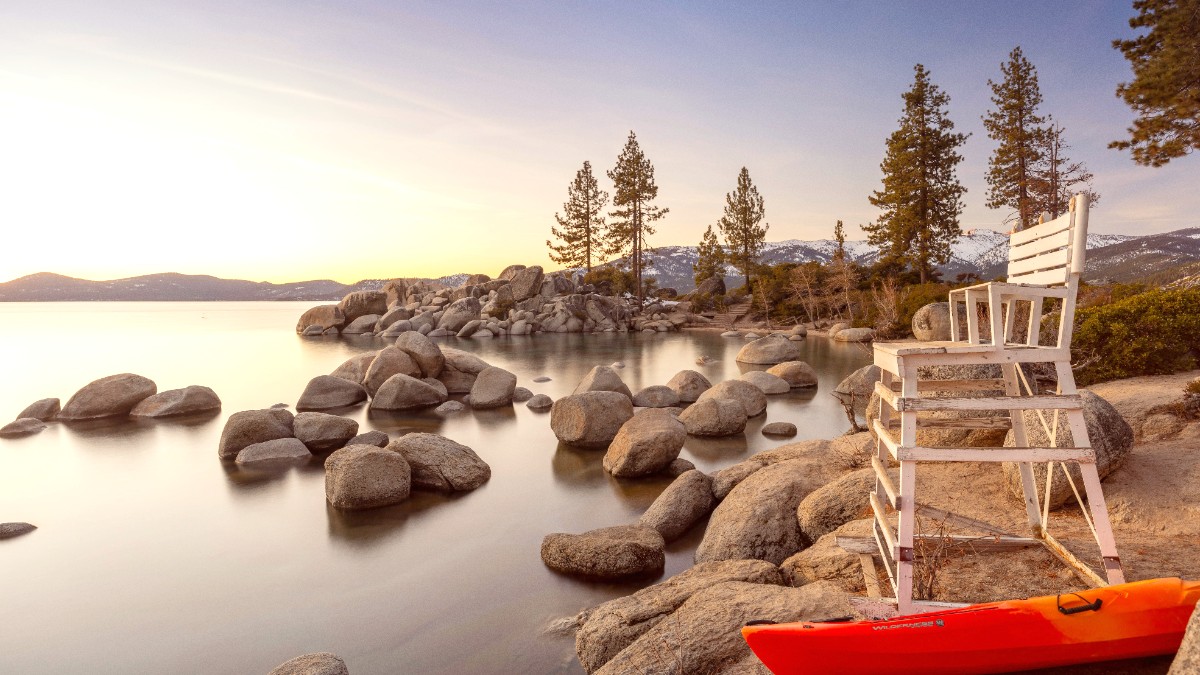
Nevada, USA
Lake Tahoe is a high-altitude destination. The lake's average elevation is 6,225 feet (1,897 meters). This elevation brings specific weather characteristics. Summer (June-August) brings warm, dry days, with average high temperatures typically ranging from 70-80°F (21-27°C). Nights are cool, often dropping into the 40s°F (4-9°C). Humidity remains low. Precipitation is minimal, mostly afternoon thunderstorms. This is the prime time for lake activities.
Winter (December-March) is cold and snowy, good for winter sports. Average high temperatures generally stay in the 30s°F (0-4°C). Lows range from the teens to 20s°F (-12 to -1°C). Significant snowfall is common, especially at higher elevations, providing ample snow for resorts.
Wildfires are a concern in late summer and fall (July-October), specifically during drought conditions. Smoke can severely reduce air quality. Monitor local air quality reports (e.g., AirNow.gov) before and during your trip. Air quality can change quickly.
Winter storms mean heavy snowfall that can close roads, specifically mountain passes like I-80, US-50, and CA-89. Tire chains for vehicles are often a requirement. Travel delays are common during and after major storms.
Peak activities, higher prices
Ideal weather for lake or snow activities. All attractions operate fully.
Highest prices. Substantial crowds, traffic congestion, parking can be difficult.
Fewer crowds, moderate prices
Moderate temperatures, beautiful fall colors or emerging wildflowers. Lower prices.
Variable weather, some trails may close or be muddy. Water activities may be limited.
Lowest prices, quiet experience
Significantly lower prices. Very few crowds for a quiet visit.
Unpredictable weather. Many businesses may have reduced hours or close entirely.
Mid-December to early April offers the best snow conditions and resort operations for skiing and snowboarding.
July to October presents clear trails and pleasant temperatures for hiking and mountain biking. Water sports (swimming, kayaking, paddleboarding) are best from July to September for warmer lake temperatures.
Mid-December to early April
July to October
July to September
May to October
Late September to Mid-October
Understand the documents you need for entry into the United States.
Citizens of 40 countries can travel to the U.S. For tourism or business for stays of 90 days or less without a visa through the VWP. Travelers must obtain an approved authorization via the Electronic System for Travel Authorization (ESTA) before boarding an U.S.-bound aircraft or ship.
Citizens of countries not participating in the VWP, or those planning to stay longer than 90 days, need a B-2 (tourist) visa. The application involves completing the DS-160 online form, paying a fee, and attending an interview at an U.S. Embassy or consulate in your home country.
These are daily estimates, excluding flights to and from Lake Tahoe.
Here are some price examples for various categories:
Smart travel choices can help reduce costs:
Your well-being is important. Understand health and safety guidelines for Lake Tahoe.
Lake Tahoe's elevation (6,225 feet / 1,897 meters at lake level) can cause mild altitude sickness symptoms like headache, nausea, dizziness, and fatigue. Hydrate well. Avoid alcohol and strenuous activity on your first day. Gradually ascend to higher elevations.
UV radiation is more intense at high altitudes. Use high-SPF Sunscreen SPF 50+. Wear a Wide-brim hat and Sunglasses, even on cloudy days or in winter. Dry mountain air and increased activity can lead to dehydration. Drink plenty of water throughout the day. Carry a Reusable water bottle.
Barton Memorial Hospital (South Lake Tahoe) and Tahoe Forest Hospital (Truckee) are main care facilities. Urgent Care Clinics are also available for non-emergency needs.
Barton Memorial Hospital: 2170 South Ave, South Lake Tahoe, CA 96150
Dial 911 for police, fire, or medical emergencies.
Lake Tahoe has a low crime rate and is considered safe for tourists. Crime statistics show no specific neighborhoods warrant avoidance. Basic common sense precautions are always good.
Avoid leaving valuables visible in parked cars, especially at trailheads.
Be aware of your surroundings at night, specifically in crowded areas.
Wildfires are a risk from late spring to fall; monitor conditions. Avalanches are a risk in backcountry areas during/after heavy snowfall. Blizzards/heavy snow lead to road closures and power outages in winter.
Monitor fire conditions via local news and official sources (e.g., InciWeb).
Backcountry travelers need avalanche training and equipment.
| Category | Details | Prevention/Notes |
|---|---|---|
| Vaccinations | Routine vaccinations up-to-date; seasonal flu shot recommended. | No specific required vaccinations for entry to U.S. |
| Water & Food Safety | Tap water is safe. High food hygiene standards. | No specific precautions beyond standard practices. |
| Travel Insurance | Highly recommended for medical emergencies, trip interruption, lost luggage. | U.S. Healthcare costs are very high for non-residents without insurance. |